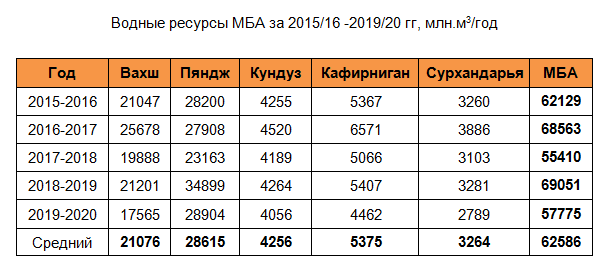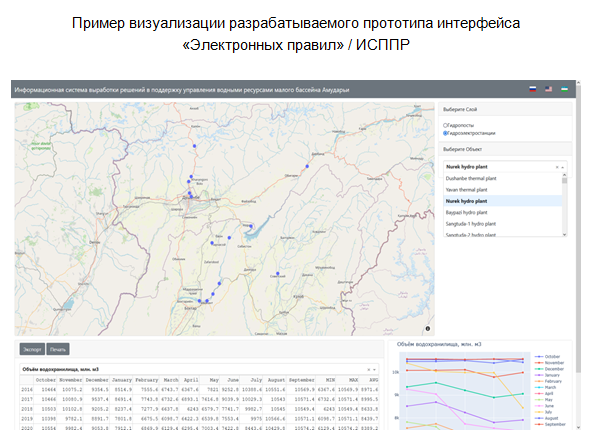
Development of E-rules of Intra-annual Flow Regulation in the Amu Darya River Basin

Client: Ministry of Innovative Development of Uzbekistan
Executing organization: SIC ICWC, partner: BWO Amu Darya, Institute of Geographic Sciences and Natural Resources Research of the Chinese Academy of Sciences.
Implementation period: 2021-2022
Project objective: Developing e-rules of intra-annual flow regulation in the Amu Darya River basin, including:
1. Modeling the flow of the Amu Darya River and its tributaries: current level (2020), perspective (2035) – modeling the annual flow and the intra-annual flow, determination of a share of the glacial component in the river runoff;
2. Estimation of the required water intake from the Amu Darya River and its tributaries for various water consumers: current level (2020), perspective (2035) – assessment of crop water requirements, taking into account the impact of climate change; assessment of water requirements of non-agricultural sectors, including Afghanistan, and determination of water needs of the Aral Sea;
3. Studying the components of the river’s water balance and development of a dynamic model of the Amu Darya river flow transformation – development of the relationships for calculation of the components of the water balance and the dynamic model.
4. Developing the information-software package called “E-rules” in support of decisions on water management along the Amu Darya River.
Outputs:
The research activities 2021 were undertaken in the following areas:
1. The quantitative assessment of natural water resources of the Amu Darya River was made and the share of the glacial component in the river runoff was determined; the series of the annual river flow and its intra-annual distribution were simulated for 2020-2035;

2. The assessment of consumption of water in transboundary rivers of the Amu Darya basin was made, environmental flow requirements were determined and needed water supply to South Aral region (Amu Darya delta) and Large Aral Sea was estimated based for the condition of stabilization of its water regime;
3. The studies were carried out and relationships for river water balance components were derived. Based on these relationships, the model and algorithms of planning water distribution and flow regulation by reservoirs, as well as the model of operational management that allows correcting the initial plan of water distribution and flow regulation by reservoirs were developed; the dynamic model and the algorithm for calculation of daily river hydrograph transformation in space and time were developed. The existing approaches to calculation of morphometric relationships of the Amu Darya River were analyzed, they were tested and compared with morphometric relationships derived from processing of satellite images covering the middle and lower reaches of the Amu Darya River. Additionally, water losses in the Amu Darya river and reservoirs of Tuyamuyun Hydroscheme were assessed using the data from the past research. The river course was divided into balancing sites, where formation of seepage flow is characteristic, for instance, in the river reach from Kerki gauging station to Il’chik gauging station the river forms, through seepage, the underflow, which in the next reach from Il’chik gauging station to Darganata gauging station is discharged into the river (inverse seepage). The seepage flow in the form of water losses from reservoirs of Tuyamuyun Hydroscheme is formed only under high water level (large quantities of water) in the reservoirs. There are no seepage losses when storage is below the dead level. Testing of the dynamic model will be done in early 2022 as scheduled by the work plan.
4. The following additional sub-tasks were fulfilled: i) analysis of the current performance of BWO Amu Darya and its territorial division in part of planning and operational management of water resources in the Amu Darya basin; ii) requirements of BWO Amu Darya for the development of the Amu Darya River water management e-rules were determined; iii) developed structure and composition of water management e-rules for the Amu Darya River.

The completed research and analysis of BWO’s operations show that, at present, water allocation by BWO Amu Darya can be characterized as conflict-free and shows reasonably good agreement between planned and actual water supply from the Amu Darya River to the countries as a whole, by season in average or wet years. Management problems occur in particularly dry years, when the lower reaches are disadvantaged against the middle reaches. It is especially important to draw correctly the river water balance by river reach and the TMHS reservoir balance for such periods of time.
The work done allowed us to determine more precisely the components of river water balance in the middle and lower reaches of the Amu Darya and of TMHS reservoir balance. The test calculations show that drawing the Amu Darya river water balance with account of the studied components of river water balance improve the accuracy of planning water distribution and flow regulation in the Amu Darya basin. Discrepancies in the actual water balance decrease substantially. The analysis of river water losses derived from the proposed algorithms leads to some important conclusions on admissible discrepancies of river water balance.

In 2022, the following was achieved:
1. Research finished under Task 3 (studying the components of the river water balance and development of a dynamic model of the Amu Darya River flow transformation) – test calculations and numerical experiments were done to prepare analytical information for recommendations.
2. Research finished under Task 4 (development of the information-software package “E-rules”).
3. Training held the at BWO Amu Darya in how to work with the E-rules.
4. Final report drafted based on the results of work done in 2021-2022.
5. Positive feedback received (internal and external reviews).
6. Report considered at the meeting of the Scientific-Technical Council of SIC ICWC, which decided: the report can be recommended for approval, and this research work can be recommended for continuation in 2023. To this end, the trial operation of Amu Dary River flow management e-rules at BWO Amu Darya should be included in the work plan of SIC ICWC for 2023.
Major outcomes:
1. A package of models and algorithms realized in codes that together with the DB and web-interface form the information-software package “E-rules”.
2. Recommendations on the production of river water balances and flow regulation rules.
In 2021, the work was done under the leadership of Prof. V.A. Dukhovniy, who recommended solving a number of additional (to the existing work plan) important tasks to increase scientific and practical value of the work in part of water management methodology. In 2022, the efforts were focused on programming of the interface of the E-rules package, coupling of models and DB, and development of recommendations.
A hypothesis and related algorithm on formation of seepage flow in the middle and lower reaches of the Amu Darya River and on formation of underflow (Kerki-Il’chik reach) and discharge zone of the inderflow into the river (Il’chik-Darganata reach) can be considered as innovative ones. This hypothesis laid the basis for a method for calculation of river balance components, in particular, water losses in the river.
The analysis and updating, using the RS-based monitoring through processing of satellite images of water surface area of the Amu Darya River in the Kelif g/s – Samanbai g/s reach, of morphometric relationships for the Amu Darya River should be noted as well. This allowed calculation of the mean width and depth of the river, as well water surface area, evaporation and changes in water volume in the river course (channel storage).
The research team justifies (based on earlier modeling results) the hypothesis of seepage losses from Tuyamuyun Hydroscheme’s (TMHS) reservoirs and relates the seepage process to operation regime of the in-stream reservoir, indicating to decreased seepage losses at lower level in the in-stream reservoir. The method for calculation of water losses in TMHS reservoirs, built on this hypothesis, is an innovative contribution to TMHS reservoir balance practices of BWO Amu Darya.
Recommendations on flow regulation rules for the Nurek Hydroscheme and TMHS, where the authors attempted to build “new rule curves” based on practices of flow regulation by reservoirs over the past 30 years, is of practical value for BWO Amu Darya.
